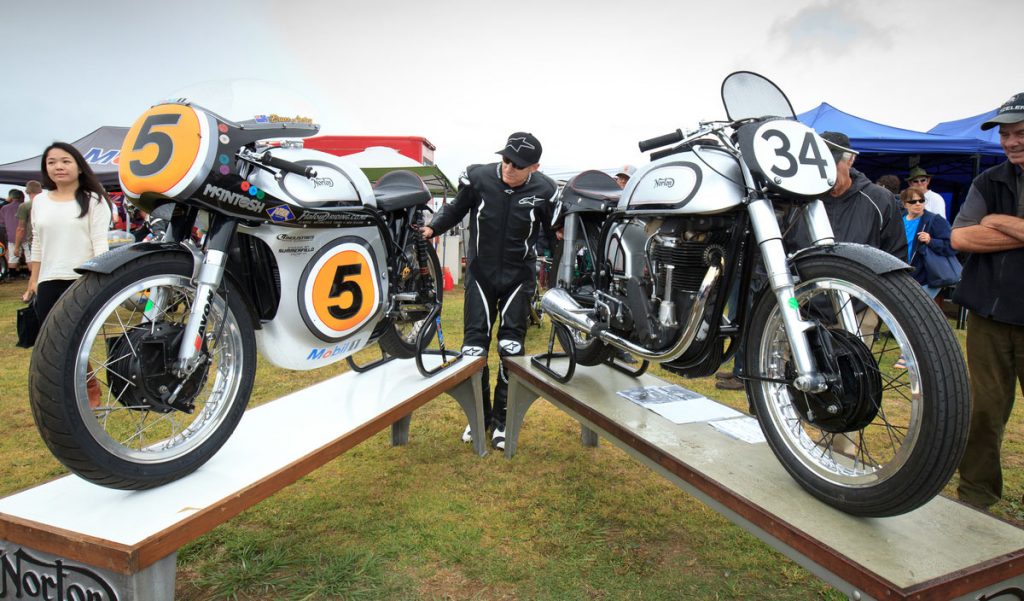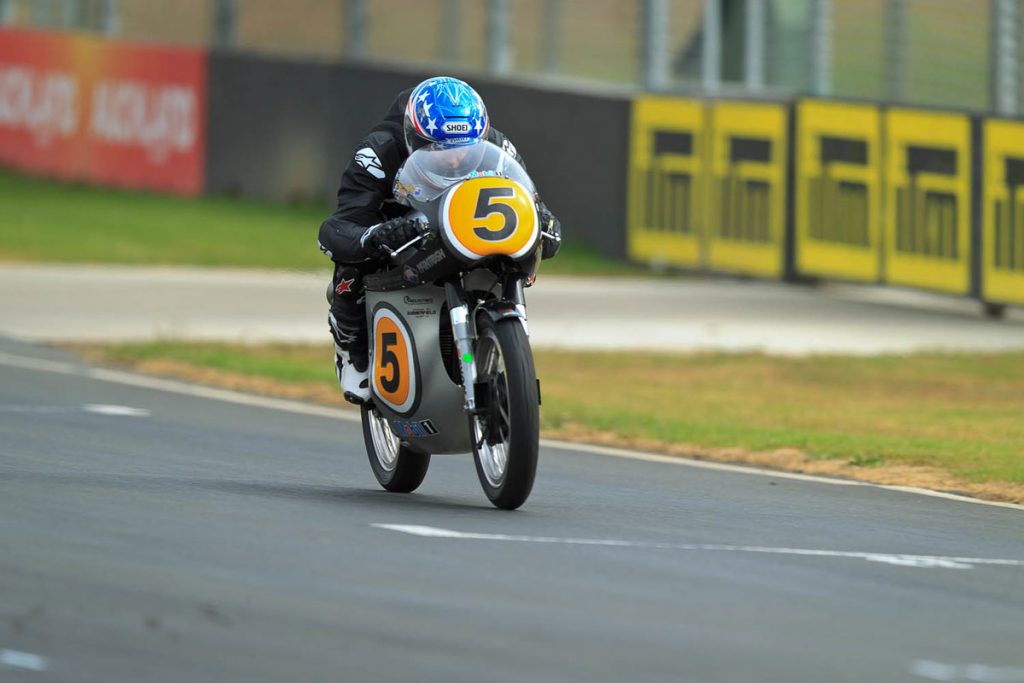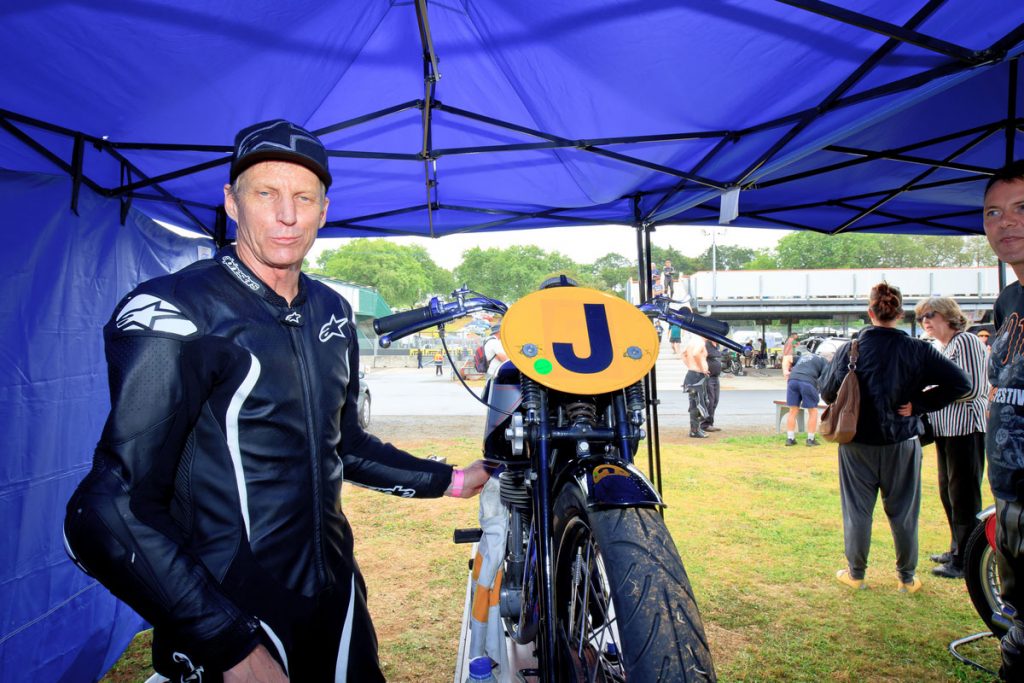Editor’s note: John Stein is one of the few people to have ridden the Ken McIntosh 1962 Manx Norton that took Bruce Anstey to victory in the 2014 Classic TT.
In the 1950s, John Surtees rode one on his way up the ladder to Grand Prix cars. So did Mike Hailwood, and Stirling Moss got his racing start in a revolutionary rear-engine Cooper F3 powered by one. But remarkably, over a half-century later, the Manx Norton legend continues to grow. That’s because last summer, nine-time Isle of Man winner Bruce Anstey rode this New Zealand-built replica to victory in the GP1 class at the 2014 Classic TT, winning the Hailwood Trophy with a fastest lap of 108.1 mph, the best ever for a Manx Norton. This further defines the Kiwi rider, who is already the fastest rider ever on the island, lapping at 132.298 mph on his Honda Fireblade during the 2014 Superbike TT.
Built in Birmingham from 1950 to 1962, Norton’s “Featherbed” Manx GP racer is widely considered the quintessential British racebike. So successful was the design that Vanwall used its engine as the basis for its Formula One car in the 1950s. Now 53 years after the final Manx left the factory, independent bike makers are still faithfully recreating them.
Norton’s double-cradle “Featherbed” frame with swingarm rear suspension set the world standard for handling in its day, directly inspiring the top production motorcycle frames into the mid-1980s. Its rock-solid handling remains impressive now. Other period technologies included the robust single-cylinder engine with magnesium cases and cam box, bevel gear-driven DOHC, and high overall component quality.
Instead of the 7000-rpm redline common for 500cc singles of the period, this special Manx’s redline is set at 8600 rpm. In comparison to bikes of the period, it also has smaller 18-inch wheels, a short, high exhaust, a close-ratio, six-speed TT Industries gearbox, and big-bore/short-stroke dimensions. Builder Ken McIntosh declined to state the output of its British-built Summerfield engine, but it’s likely close to 60bhp.

Even before it won at the IOM, this bike had history. McIntosh built it for himself, but soon realised it needed a better rider. That led to races with American Kevin Schwantz, Kiwi Andrew Stroud, Aussie Cameron Donald, American Doug Polen and finally Anstey aboard. To date it’s won 35 of 49 races entered.
The Manx is long and low, and you sit well back in the cockpit, with your bum over the rear wheel. But there are scallops in the tank for wrists and knees, so you can tuck behind the Avon-style fairing. McIntosh converted this bike’s right-side gearshift to the left, with a one-up, five-down racing pattern. The four-leading shoe magnesium front brake, single leading-shoe magnesium rear brake, and dry clutch are all cable operated, and have a strong mechanical feel.
Details include needle bearings for the swingarm, modified fork dampers, and Works Performance UltraLite titanium shocks. And yet McIntosh stayed true to the geometry and construction of the original “Featherbed” frames, which were oxyacetylene bronze-welded high-tensile steel.
There is no ignition switch or starter button. At New Zealand’s Pukekohe Park Raceway near Auckland I turn on the petcock and flood the Amal GP carb. The bike is not extremely light; weighing 320 lbs (145kg) dry, it is typical for the day. Click it into first gear and back up on compression, and then, clutch in, onto a roller starter. Then drop the clutch and a piston nearly the size of a smallblock Chevy’s slams toward the roof of the two-valve combustion chamber, and the Lucas magneto lights the avgas mixture. Ba-ba-ba-wham! Suddenly I’m astride a bellowing, jangling, vibrating beast. The dry clutch spins near my left foot. Finally it’s ready to rev. Up for first, slip the clutch, and we ease down pit lane. A little more throttle and the entire bike now comes alive. After a warm-up lap, it’s go time.

Accelerating onto the front straightaway, the Manx hunkers down and lunges forward. Instantaneously, it evokes the feeling of a way more modern superbike: stable, linear, and utterly on rails. There’s no upsetting this motorcycle. The “on rails” feeling continues into the fast, right-hand turn one. Next comes a quick left-right flick, which the Norton manages briskly, that leads into Castrol Corner, a sharp right-hander leading onto the long back straight. Here the revs fall to 3000 rpm, but amazingly the engine pulls to redline without so much as a hiccup. And the close-ratio transmission clicks off gears with a short throw and level effort reminiscent of a modern box. Without onboard data acquisition, it’s impossible to measure the performance, but an onboard camera of Anstey at the TT shows the tach hovering at nearly 8000 rpm in top gear, suggesting maximum velocity is a bit above 140 mph.
Scrubbing off that kind of speed isn’t difficult for modern sports bikes, but it takes more doing on the Manx. The lever effort on the four-shoe front brake is heavy, and it doesn’t telegraph nearly the feel of a good disc setup. Despite this, with the sticky Avon race rubber the Manx gets slowed down well enough for a right-left chicane at the end of the back straight.
Maybe the part of the Pukekohe circuit that really speaks to the Manx’s inherent goodness is the last turn, a cresting right-hander – ringed by a foreboding concrete wall – that can unweight bikes as they’re fully leaned over. Getting it right is crucial for speed along the front straight… and also for staying alive. The Manx leans over and laser-locks onto a line. In these critical few seconds, every message imparted through the grips, seat and pegs communicates confidence and stability, which, together with speed and reliability, propelled Anstey to win the Hailwood Trophy.

It all proves that in 1950, when Irishman Rex McCandless designed the works Manx’s Featherbed frame, he got it spot-on. And this, together with the inspiring engine, precision chassis and excellent finish work, makes this replica a thoroughly enticing ride experience.
Anstey’s IOM-winning bike isn’t for sale, but McIntosh Racing offers an exact copy that he calls the “Schwantz Spec” Manx for the equivalent of about £42,000. The shop has built a half-dozen copies so far. That’s a bit above what original Manxes often sell for, a surprising contrast to the classic car world, where real examples out-value replicas many times over. And yet, given the winning performance, craftsmanship, total usability and sheer beauty of the piece, the approach makes a lot of sense as functioning art. If you want history, go buy an original Manx. If you want a jangling, bellowing history lesson in an asphalt classroom that delivers understanding and appreciation of 1960s racing the rest of the world will never know, here’s your machine.
Class dismissed.
Read more
Friends reunited: Why I need a Norton Commando back in my life
With a featherbed ride and punchy twin-cylinder, the Norton Dominator 650SS really did dominate the road













I came across your 1962 Manx Norton – Motorcycle Racing | Hagerty Articles website and wanted to let you know that we have decided to open our POWERFUL and PRIVATE web traffic system to the public for a limited time! You can sign up for our targeted traffic network with a free trial as we make this offer available again. If you need targeted traffic that is interested in your subject matter or products start your free trial today: http://xahl.de/p Unsubscribe here: http://xahl.de/q
Hello.. we have analyzed million of websites online, and we have found that your website is one of few thousands of websites that has low daily traffic, this will effect your daily sales and leads, would you like to learn how to increase your daily traffic for free? if you like just say yes, or visit this quide here>> https://warriorplus.com/o2/a/qqvwm/0 if not just reply with no and we will not email you anymore. Thanks
Pinky’s Celebrity Club is a very easy-to-use and powerful desktop software that will allow you to gain Instagram post likes, followers and comments completely organically! The way it works is you login via your Instagram account, set hashtags and enter your comments. The software will then search for all posts that have your hashtags and then like them, comment on them and follow the users (you can tell what the software should do: follow, comment or/and like posts). This is a great way to organically grow your Instagram followers. The software simply does what you would otherwise do manually, but on a complete autopilot (24/7). The software also has some delay settings to make sure that all of your activity looks natural. Try PINKY’S CELEBRITY CLUB INSTAGRAM BOT FOR REAL FOLLOWERS AND LIKES for free and see for yourself just how powerful and easy to use the Instagram software is! To learn more head to https://wowitloveithaveit.com/products/pinkys-celebrity-club-instagram-management-software